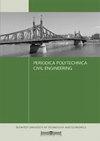钢- clt螺栓复合连接试验研究及有限元模型
IF 1.4
4区 工程技术
Q3 ENGINEERING, CIVIL
引用次数: 0
摘要
与纯钢结构和纯木结构相比,钢木复合结构具有许多优点。复合结构中最重要的部分之一是复合连接。本研究的对象是钢-CLT复合连接组成的钢型材,交叉层压木材(CLT)面板和螺栓螺母和垫圈。研究的目的是建立一种高效的钢- clt复合连接的有限元模型,并对其进行试验验证。研究过程包括以下几个步骤:采用非对称推出试验对所考虑的连接进行实验测试,采用有限元法对连接进行数值建模和分析,使用实验结果对数值模型进行验证,以及对所提出的数值模型进行参数化研究。对于数值分析,提出了一种创新的木材建模方法。实验结果与数值研究结果的对比表明,所提出的数值模型便于实际应用于结构分析。参数分析表明,在某些情况下,连接出现非典型破坏模式。根据记录的行为,建议整体计算连接的承载能力,同时考虑连接强度的主要部分(Johansen’s)和次要部分(绳索效应),而不是部分,如EN标准所建议的那样。本文章由计算机程序翻译,如有差异,请以英文原文为准。
Experimental Research and FE Model of a Bolted Steel-CLT Composite Connection
Steel-timber composite structures have numerous advantages compared to steel only and timber only structures. One of the most important parts of a composite structure is the composite connection. Object of this research was a steel-CLT composite connection consisting of a steel profile, a cross-laminated timber (CLT) panel and a bolt with nut and washer. Aim of the research was to develop an efficient finite element (FE) model of a bolted steel-CLT composite connection and to validate it experimentally. The research process consisted of several steps: experimental testing of the considered connection using asymmetrical push-out test, numerical modelling and analysis of the connection using Finite Element Method (FEM), validation of the numerical model using experimental results, and parametric study of the proposed numerical model. For numerical analysis, an innovative method for timber modelling has been proposed. The comparison between the experimental and numerical research results demonstrated that the proposed numerical model was convenient for practical application in structure analyses. The parametric study showed that, in some cases, atypical failure modes of the connection occurred. Based on registered behavior, a recommendation is given to calculate the load capacity of the connection integrally, taking into account both the primary (Johansen’s) and the secondary (rope effect) part of the connection strength, instead partially, as proposed by EN standards.
求助全文
通过发布文献求助,成功后即可免费获取论文全文。
去求助
来源期刊

Periodica Polytechnica-Civil Engineering
工程技术-工程:土木
CiteScore
3.40
自引率
16.70%
发文量
89
审稿时长
12 months
期刊介绍:
Periodica Polytechnica Civil Engineering is a peer reviewed scientific journal published by the Faculty of Civil Engineering of the Budapest University of Technology and Economics. It was founded in 1957. Publication frequency: quarterly.
Periodica Polytechnica Civil Engineering publishes both research and application oriented papers, in the area of civil engineering.
The main scope of the journal is to publish original research articles in the wide field of civil engineering, including geodesy and surveying, construction materials and engineering geology, photogrammetry and geoinformatics, geotechnics, structural engineering, architectural engineering, structural mechanics, highway and railway engineering, hydraulic and water resources engineering, sanitary and environmental engineering, engineering optimisation and history of civil engineering. The journal is abstracted by several international databases, see the main page.
 求助内容:
求助内容: 应助结果提醒方式:
应助结果提醒方式:


